Incandescent Light Bulb Emission Spectrum
I love my Philips Hue lighting system, which I bought over a yr ago. The system allows yous to set millions of dissimilar colors and thousands of effulgence levels for up to 18 bulbs using a smartphone. You lot can also program the system to automatically plow on as y'all arroyo your residence, known as geofencing, or at specific times of the day. But how does the light quality compare to that of other lighting technologies?
An Intuitive Home Lighting System
The Philips Hue system works by varying the amount of blue, green, and cherry calorie-free that is output, which y'all can set directly from your smartphone. If you are sensitive to a specific colour of low-cal, yous can simply avoid it. You tin can set the lighting depending on your mood to help concentrate, energize, read, or relax. For example, there is a "Concentrate" mode that preferentially outputs more blue light, which has shown to raise the ability to concentrate. When relaxing in the evenings, I apply the "Sunset" manner, which provides more than red and orange tints.
Having lived with the system for a while now, I've also found some long-term advantages:
- I tend to fall comatose more easily at nighttime, compared to when I had my old fluorescent lights.
- My electricity bill has dropped by roughly $21 per calendar month since upgrading the system. This is because a 12 W calorie-free-emitting diode (LED) seedling tin can produce the aforementioned optical output as a sixty W incandescent bulb.
A comparing of some of the lighting system'due south settings in my apartment. Left: Soft white. Middle: Reddish. Right: Blue rain.
I tried disarming my parents to buy the organisation, but my sales pitch didn't sway them. I recently bought them the organization as a Christmas present, since I am such a skillful son. The first annotate I heard when demonstrating the system was: "Wow, the light feels so natural." This prompted me to investigate why this is, and whether COMSOL Multiphysics® software tin be used to investigate the underlying physics. The reply lies in the emission spectrum produced by the high-efficiency LED bulbs. Past comparing the emission spectrum of natural light to that produced by incandescent, fluorescent, and LED bulbs, we tin better understand this miracle.
Plotting Emission Spectra in COMSOL Multiphysics
The emission spectra for natural daylight, too equally incandescent, fluorescent, and LED bulbs, are plotted below. As you will see, the emission spectra are very different, and none of them can perfectly replicate natural daylight.
Natural Daylight
Let's start with daylight arriving at the globe'south surface from the sun. At that place is currently no way of reproducing the emission spectrum with a manmade light source. Yet, lite pipes (or light tubes) can exist used to redirect incoming daylight into underground locations, such equally subway stations. One example of this is the subterranean railroad train station in Berlin. A lite pipe extends out above the station (shown below, in the left image) and collects light, which is transmitted through a special pipe and downwardly into the station hugger-mugger (shown below, on the right).
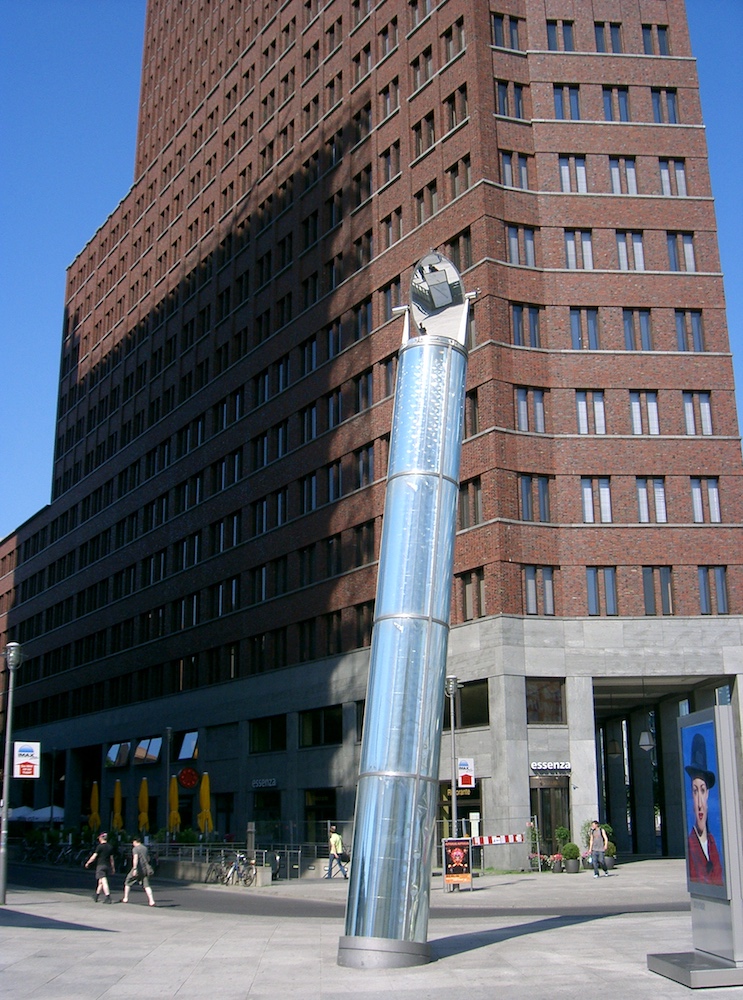
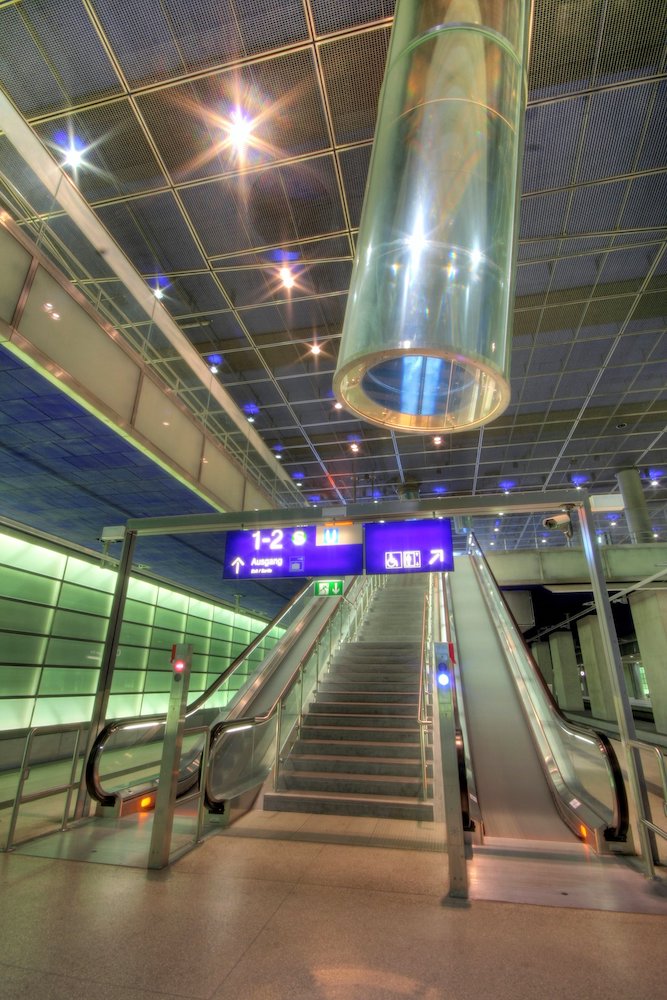
Left: A light tube at the entrance to a train station in Berlin. Paradigm by Dabbelju — Own work. Licensed nether CC BY-SA 3.0, via Wikimedia Commons. Right: The calorie-free tube transmits light into the hole-and-corner terminal. Image by Till Krech — Flickr. Licensed under CC BY two.0, via Wikimedia Commons.
The light pipe creates a more natural illumination of the railroad train station during the day. The obvious drawback of this arroyo is that it won't work during the nighttime, creating the need for an bogus lite form that mimics natural daylight.
The emission spectrum for natural lite generally follows the Planck distribution in the visible part of the spectrum, as we tin see below. No color is dramatically favored over another, although the intensity is highest in the low-cal blue region, around 460 nm.
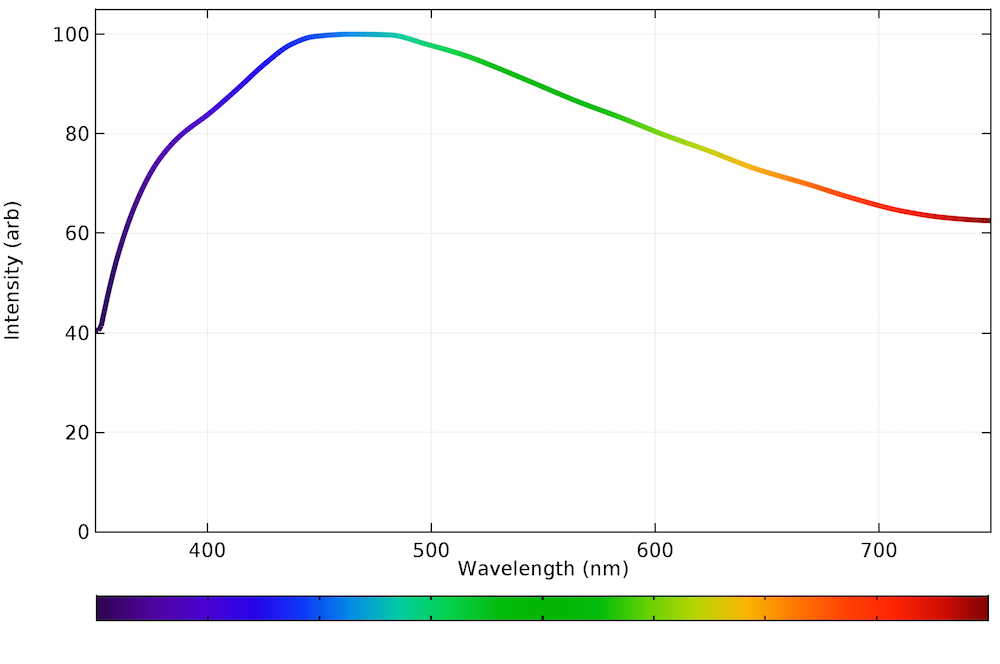
The emission spectrum of visible light arriving at the world'southward surface from the dominicus.
Incandescent Bulbs
An incandescent lite bulb contains a tungsten filament that is resistively heated when a current is conducted through it. At temperatures around 2000 K, the filament starts to emit visible light. To prevent the tungsten wire from called-for up, the bulb is filled with a gas, usually argon. The heat generated in the filament is transported to the surroundings through radiations, convection, and conduction. An incandescent bulb emits a greater proportion of red calorie-free than natural daylight. Emission even extends into the infrared role of the electromagnetic spectrum, which wastes energy and reduces the overall efficiency of the bulb.

The emission spectrum in the visible range of a typical incandescent bulb.
Fluorescent Bulbs
A fluorescent lamp typically consists of a long, glass tube containing a low-pressure mixture of mercury and a rare gas, such as argon. Within of this tube, a nonequilibrium discharge is produced (a plasma). This means that the electron temperature is different from the temperature of the surrounding gas mixture. For example, the electron temperature can be on the society of over 20,000 K, but the gas temperature stays relatively close to room temperature, 300 K. Since the plasma is not in equilibrium, the electron impact reactions change the chemical composition of the gas mixture in a manner governed by the collisional processes. These collisions can produce electronically excited neutrals, which can subsequently produce spontaneous emission of photons at specific wavelengths.
Visible low-cal is produced by ii mechanisms: optical emission direct from the belch, or past exciting phosphors on the surface of the tube. Fluorescent lights often crusade bug for people suffering from a visual disorder called Irlen syndrome, and anecdotally, people often complain of headaches and migraines when exposed to fluorescent lights for extended periods of time.
As y'all tin run across in the graph below, the emission spectrum in a fluorescent light source looks rather strange. The quantization is either due to straight emission from the plasma or past the phosphors, but to a human eye, the light emitted still seems white. Like incandescent bulbs, fluorescent bulbs can exist inefficient because the plasma needs to exist sustained and information technology emits radiation in the nonvisible range.

The emission spectrum of a typical fluorescent bulb.
LED Bulbs
LEDs are revolutionizing the lighting industry, as they are ofttimes much more than efficient in terms of the luminous efficacy and more than durable than traditional incandescent low-cal technologies. For example, typical consumer LED light bulbs operate at 10-20% of the ability needed to run an incandescent bulb of comparable brightness. They besides accept lifetimes of over 25,000 hours, compared to only 1000 hours for incandescent bulbs.
LEDs are then much more efficient than incandescent bulbs considering they part in a very unlike way. LEDs are semiconductor devices that emit light when electrons in the conduction band transition across the bandgap via radiative recombination with holes in the valence band. Different incandescent bulbs, LEDs emit low-cal over a very narrow range of wavelengths.
Initially, red, light-green, and xanthous LEDs were developed in the 1950s and 1960s. Yet, it was the invention of the bluish LED that led to the creation of new, efficient white light sources. Blue light emitted from such LEDs tin be used to stimulate a wider spectrum of emission from a phosphor layer around the LED casing, or tin can be direct combined with red and light-green LEDs to create white calorie-free.
As shown in the graph below, the LED spectra for a yellow phosphor setting gets closer to that of natural daylight. In that location is more than blue low-cal than the incandescent bulb and nigh all of the power is emitted within the visible spectrum.
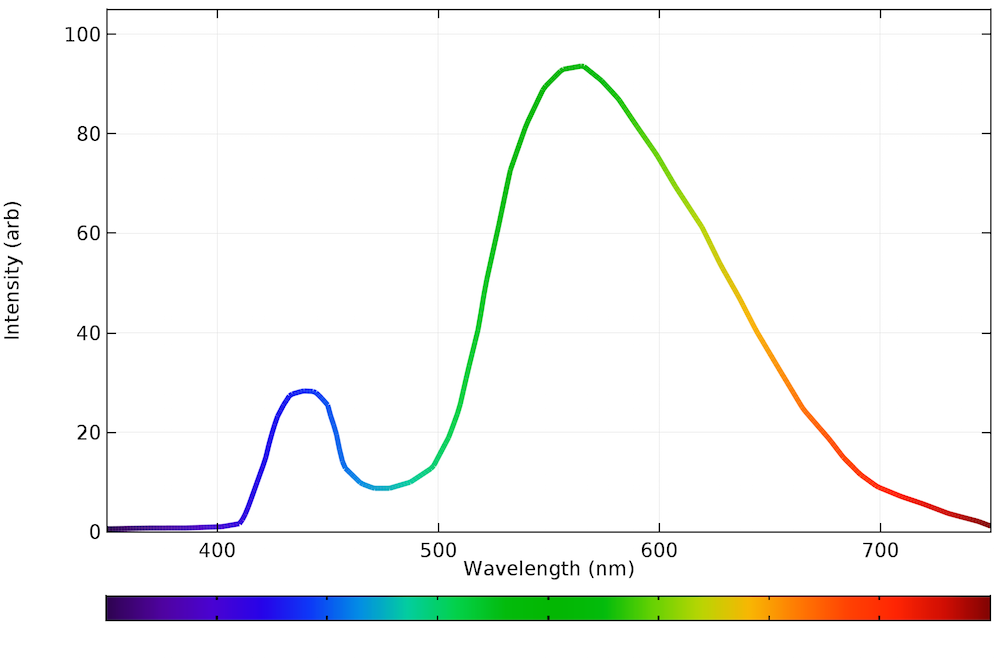
The emission spectrum of a typical LED bulb on a warm, white setting.
Combined Light Sources
The different emission spectra are plotted on the aforementioned axis beneath. While none of the bulbs exactly reproduce natural daylight, the LED bulb is conspicuously the best approximation. All of the emission occurs within the visible range, making the device very efficient.
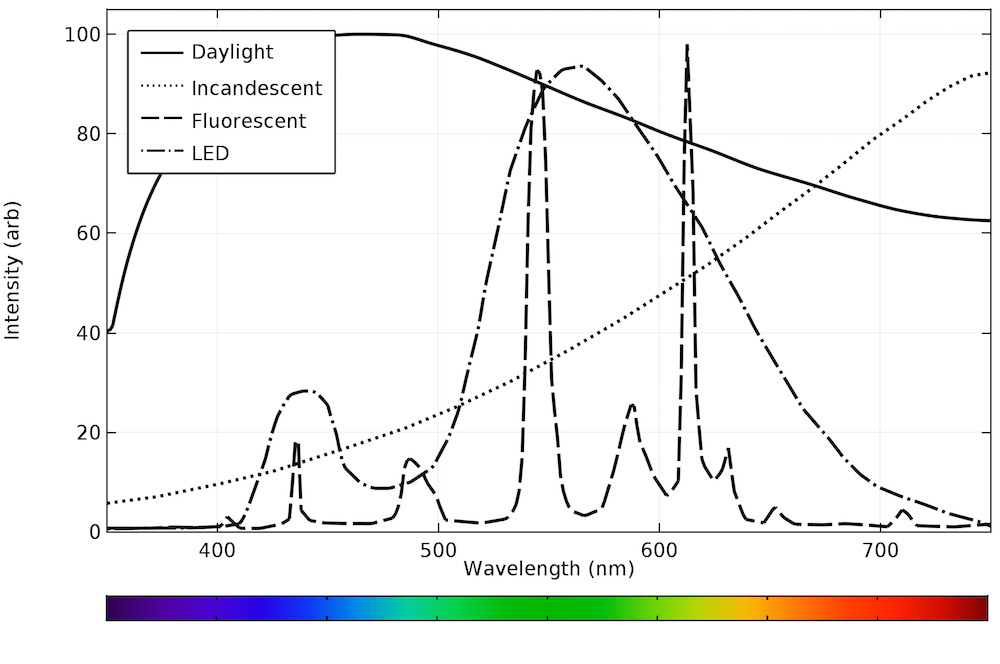
Emission spectra from daylight and typical incandescent, fluorescent, and LED bulbs.
In general, incandescent and fluorescent bulbs have a fixed optical output. LED bulbs with a fixed emission spectrum are also available. By plotting the emission spectra of the unlike low-cal sources, we can infer that LED bulbs most closely replicate natural daylight.
Discover More Means to Model Low-cal Sources
As we've seen in this weblog post, there are many different ways of creating bogus light. All of the methods described above can exist modeled in various levels of particular using COMSOL Multiphysics with either the Semiconductor, Plasma, Heat Transfer, or Ray Optics modules.
- Read a blog post:
- Creating a Wavelength Tunable LED Simulation App
- Modeling a Light Seedling, All Forms of Heat Transfer
- An Analysis of Caustic Surface Generation at the Vdara Hotel
- Download a tutorial model:
- Electrodeless Lamp
- Transparent Calorie-free Pipage
PHILIPS is a registered trademark of Koninklijke Philips Northward.V. and its affiliates.
Incandescent Light Bulb Emission Spectrum,
Source: https://www.comsol.com/blogs/calculating-the-emission-spectra-from-common-light-sources/
Posted by: davisexcleduess.blogspot.com



0 Response to "Incandescent Light Bulb Emission Spectrum"
Post a Comment